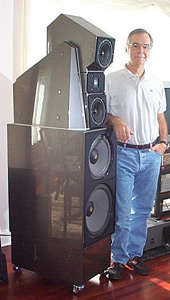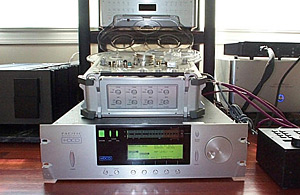![[SoundStage!]](../sslogo3.gif) Surrounded! Surrounded!Back Issue Article |
January 2002 A Visit from Peter McGrath of Wilson Audio Specialties -- Part One It was to be a memorable experience. Peter McGrath and I were playing some tunes to make sure the multichannel playback system we had assembled was operating optimally. In short order, we established, to my and Peter’s satisfaction -- no, make that delight -- that everything was working properly and the setup was tweaked to perfection. Right off the bat everything just sounded right. I won’t bore you with all the audiophile dogma; let's just say that all the superlatives you’ve read applied in spades. Superbowl of surround
As listeners, if we are truly going to evaluate the ability of surround sound to further the musical experience, we must first remove the potential pitfalls of the medium. And boy, are there a few! As much as a studio recording can re-create a facsimile of the sound of live music, it does present a less-than-experienced recording engineer with the opportunity to make mistakes. In this instance, the difference between an artificial rendering (an engineer’s idea of live sound) versus the actual event in a live hall put down on tape could make all the difference in playback. It’s the old plague of audiophilia: Is what you are hearing attributable to what you believe it is, or is it something else altogether? When you are listening to master tapes set up by the recording engineer on a state-of-the-art playback system he is expertly familiar with, you have removed almost all the possible pitfalls. Whether the sound succeeded or failed on this day would be due to an increasingly minute number of variables. Timeout Maybe we need to back up for a few moments and examine why Wilson Audio Specialties’ Peter McGrath was here in the first place. The roots of this type of exercise are entrenched in the high end’s history. And you know what they say about learning from our past. Audiophiles, and more specifically, reviewers, are taught the importance of having a reference point for establishing the context from which to describe an audio component’s sound. If you know the sound of your reference system thoroughly, then the insertion of a new component and the inherent changes in the sound can be determined. This makes for the best opportunity to assess a component’s merits and describe its performance. The same holds true for software. You have to know what you are hearing through and through before you can determine if it’s the component having an audible effect on the sound or if the characteristic you’ve identified is inherent in the recording itself. It’s a slippery slope to be sure, and it’s why reviewing must be a careful task if it is to have relevance. Take note of this the next time you read an off-the-cuff comment about a demo that sounded poor, especially if the software, room, equipment, and every other variable were unfamiliar to the writer. This was the mindset I had before the arrival of Peter McGrath and his lovely wife, Elizabeth. I know what my system sounds like -- like I know the back of my hand. Given this, I was hoping to determine, by listening to Peter's recordings, what the addition of the rear-channel information did to the musical experience. I was also going to be able to listen to the same recordings in two-channel mode, so that I could conclusively note the changes wrought by the additional channels. This gave me the chance of learning something relevant, which is hard to do in the brave new world of multichannel audio. But before I describe that for you, a bit of background. The coach Peter McGrath has a vast amount of experience as a recording engineer, with many CDs to his credit. He probably has more experience than anyone recording live musical events in four-channel surround sound (using Jerry Bruck’s KFM 360 recording technique, the subject of a future article). Peter was doing this, and demonstrating it, long before the advent of multichannel SACD or DVD-A. This gave him the proverbial jumpstart on the future of recorded music, but it was also a source of eminent frustration for him. Without the ability to play back the recordings he was making outside of a system set up by himself specifically for these demonstrations, he had no way of sharing his magical work with the music-loving, audiophile public. Before Dolby Digital, DTS, SACD, or DVD-A, there was Peter, schlepping his trusty Nagra D and the rest of his gear to trade shows and converting the masses. He was ahead of his time to be sure. It was this advanced learning curve, formed through years of firsthand experience, that led me to believe Peter would ably demonstrate the art of surround playback. He is passionate about his work with the Florida Philharmonic Orchestra; his eyes light up each time he talks about it. I jumped at the chance to share in this experience, and the fact that it was going to take place in my home made it even more exciting and useful. I was looking forward to drawing some conclusions for myself that I could share with you; this would be possible sitting on my couch in my living room. What acoustic do you know better than your own home? I’ve spent hour upon hour listening to music with a plethora of equipment throughout the five years I’ve lived at my current residence. I know how music sounds when reproduced in this room. Peter was bringing approximately $100,000 of gear with him to ensure we were hearing the best possible playback. Of course, I did stand the chance of spoiling my enjoyment of what was to come after, but hey, all in the name of music, baby! Could it get even better? Yep. Peter also works for Wilson Audio Specialties. (He was one of the first Wilson dealers, at what was then his store, Sound Components, in Coral Gables, Florida.) So not only would he know the source material and playback electronics through and through, but he was also expertly prepared to assess my speaker arrangement, and tweak it if necessary, to take advantage of all this potential. And my, what a system we assembled. The dream team The Federal Express lady showed up the very morning Peter and Elizabeth were to arrive. Not a moment too soon -- we needed this stuff on time! She came armed with flight cases and suitcases, and she left with a case of strained muscles after delivering of all Peter’s gear. It sat in my foyer for several hours. It was not unlike breeding one's purebred pet with a friend’s. You just hope they will get along and, umm, interface properly. All this gear is going into my system? Lets hope it works.
The front two channels of this machine were output to a Pacific Microsonics Model One A-to-D/D-to-A converter via AES/EBU connectors (underneath Nagra unit in photo). This Keith Johnson-designed component is the very same unit used to author HDCD recordings (though now in its Model Two designation). The Model One upsamples a 44.1kHz source to 88.2kHz. Peter thinks this direct multiple is more appropriate (and sounds better) than 96kHz. The rear two channels of the Nagra D fed an Apogee DA-1000 professional DAC. This is similar to the unit marketed by Cello before its demise. Although not as sophisticated as the Pacific Microsonics unit, it was more than sufficient for rear-channel duties. From there, the four channels were fed to a Z-Systems RDM-1 reference digital mixer, custom designed for this type of application and built to Peter’s specifications. I can’t describe for you all that this unit does, but among other things, it controlled channel volume and provided the ability to turn the rear channels on and off during the demonstration. We had four identical 200W channels of amplification via the Reviewers' Choice Krell Theater Amplifier Standard, which in turn drove Wilson X-1 Grand SLAMM Series III speakers up front, and WATT/Puppy 6es in the rear. To say we had our bases covered would be an understatement. All this gear was tied together with Nordost speaker cables and Transparent Audio interconnects. Set up in my large living room, this system was a quarter-million-dollar sight to behold. But it also provided an interesting listening experience, which I'll tell you about in next month’s "Surrounded!." ...Jeff Fritz
|
|
![[SoundStage!]](../sslogo3.gif) All Contents All ContentsCopyright © 2002 SoundStage! All Rights Reserved |
 With only a weekend in front
of us, time was limited, so we got down to some serious listening rather quickly.
The majority of Peter’s recordings are of the Florida Philharmonic Orchestra, with
James Judd conducting. Being a Floridian, Peter has been able to record this orchestra
many times over the years, which has provided an opportunity for him to hone his skills.
Knowing the players and venue so well, he was able to astutely assess his success in
capturing the live sound, which in this case, is the point. Why, you ask?
With only a weekend in front
of us, time was limited, so we got down to some serious listening rather quickly.
The majority of Peter’s recordings are of the Florida Philharmonic Orchestra, with
James Judd conducting. Being a Floridian, Peter has been able to record this orchestra
many times over the years, which has provided an opportunity for him to hone his skills.
Knowing the players and venue so well, he was able to astutely assess his success in
capturing the live sound, which in this case, is the point. Why, you ask?  It was quite an amazing conglomeration. Starting with the source component, we
had the Nagra D four-track digital recorder (top unit in photo right). This Swiss beauty
uses 5" reels and .25" tape. Using all four channels, it will sample at 48kHz
with 24-bit resolution. The Nagra D was used for most all Peter’s work during the
past several years. For those not familiar with Nagra equipment, it is simply beautiful in
its construction quality and apparent level of sophistication. I want one.
It was quite an amazing conglomeration. Starting with the source component, we
had the Nagra D four-track digital recorder (top unit in photo right). This Swiss beauty
uses 5" reels and .25" tape. Using all four channels, it will sample at 48kHz
with 24-bit resolution. The Nagra D was used for most all Peter’s work during the
past several years. For those not familiar with Nagra equipment, it is simply beautiful in
its construction quality and apparent level of sophistication. I want one.